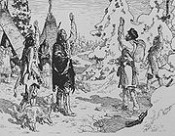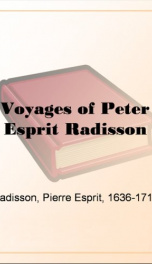Radisson Pierre Esprit

Pierre-Esprit Radisson (1636 – 1710) was a French-born explorer and mapper, whose exploration of 1668 led to the formation of the Hudson's Bay Company. He came to New France as a teenager and was captured in an Iroquois raid circa 1652, but was adopted by his captors and became accustomed to their way of life. Radisson escaped once but he was recaptured and tortured. After two years of living with the Iroquois he fled and returned to Trois-Rivières in New France from where he journeyed to the fur-trading regions of Lake Michigan and Lake Superior with his brother-in-law Médard des Groseilliers. However, as they did not have a license to trade furs, the officials in New France confiscated their furs and fined them when they returned in 1660. This voyage had however enabled them to discover the "salted sea", Hudson Bay, of which the natives spoke. They sought to start a trade company but did not receive any support from New-France. The two explorers left for Boston to interest the authorities of New England in this venture. They met English colonel George Cartwright there who took them to England and presented them to the court of King Charles II. In June 1668, they finally left England, sailing two merchant vessels chartered by Prince Rupert, the Eaglet and Nonsuch, into Hudson Bay from the north. This new shorter route eliminated the need for passing by the St. Lawrence River controlled by the French. Only the Nonsuch arrived in the bay, with Des Groseilliers on board, because the Eaglet, damaged in a storm, had to return to England with Radisson. Fort Rupert was founded at the mouth of the Rupert River. Overall, the mission was successful and in 1670 the English founded the Hudson's Bay Company (HBC). At the time of a voyage to London in 1674, Radisson and Des Groseilliers, dissatisfied by their treatment by the new company, were convinced by the Jesuit Charles Albanel to return to New-France. However, they were coldly received by the governor Frontenac, and Radisson soon returned to France and entered the Navy. In 1682 he took part in a campaign to reconquer Hudson Bay for France. Always frustrated by the French, who returned to the English a ship that he had captured, he again entered in the service of the HBC in 1684 and carried out expeditions against the French in the bay. In particular he forced his nephew to return Fort Bourbon (the French name for York Factory, Manitoba) to the HBC. From 1685 to 1687 he directed the trade at the nearby Fort Nelson, on the Nelson River. Becoming an English citizen in 1687, Radisson returned to England where he finished writing the accounts of his voyages. He retired on a small pension and dividends from the HBC and died in 1710 in poverty. Radisson had three wives and when he died in 1710, he was succeeded by his children. The towns Radisson, Quebec, Radisson, Saskatchewan, and Radisson, Wisconsin, as well as a street and Metro station in Montreal and the Radisson provincial electoral district in Manitoba are named after him. The Radisson Hotels group, starting with the Radisson hotel in Minneapolis in 1909, is also named after him. The Canadian Coast Guard also has a vessel named the CCGS Pierre Radisson. Radisson was portrayed by Paul Muni in the 1941 film Hudson's Bay.
do you like this author?
What readers are saying
What do you think? Write your own comment on this book!
write a commentWhat readers are saying
What do you think? Write your own comment on this author!
write a commentBook list

Voyages of Peter Esprit Radisson
Series:
Unknown
Year:
Unknown
Raiting:
3/5
This book was converted from its physical edition to the digital format by a community of volunteers. You may find it for free on the web. Purchase of the Kindle edition includes wireless delivery.
Show more
add to favoritesadd In favorites
Book list

Voyages of Peter Esprit Radisson
Series:
Unknown
Year:
Unknown
Raiting:
3/5
This book was converted from its physical edition to the digital format by a community of volunteers. You may find it for free on the web. Purchase of the Kindle edition includes wireless delivery.
Show more
add to favoritesadd In favorites
What readers are saying
What do you think? Write your own comment on this author!
write a commentGenre
if you like Radisson Pierre Esprit try:
readers also enjoyed
What readers are saying
What do you think? Write your own comment on this author!
write a commentGenre
if you like Radisson Pierre Esprit try:
readers also enjoyed
Do you want to exchange books? It’s EASY!
Get registered and find other users who want to give their favourite books to good hands!

